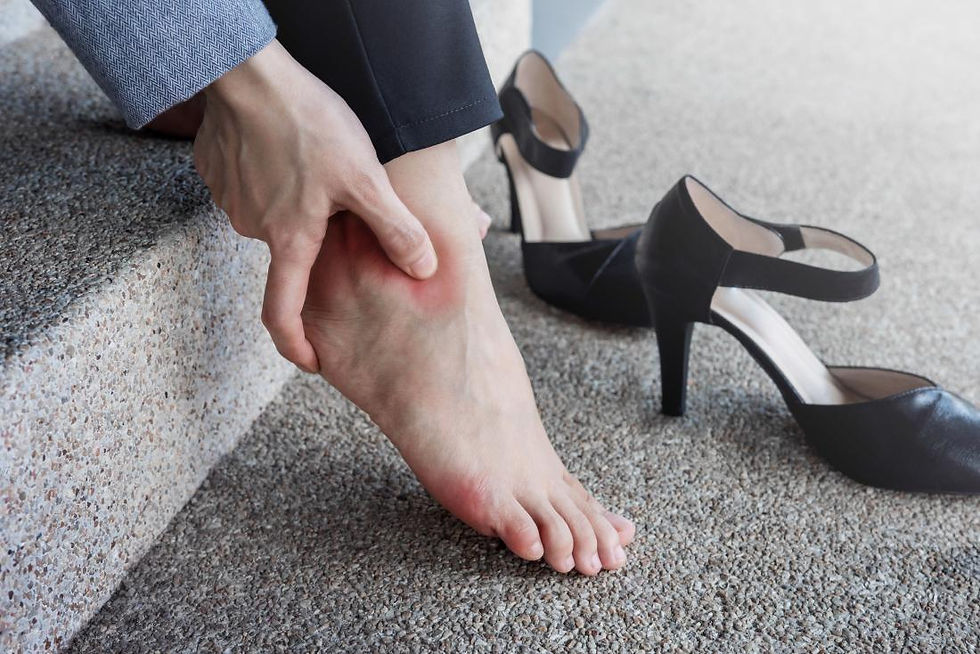Foot Problems That Lead to Swelling and Stiffness
- Dr. Chandana Halaharvi

- Sep 6
- 3 min read
Waking up with stiff feet or noticing swelling around your ankles after a long day can be frustrating. Sometimes it’s easy to brush off — “maybe I just walked too much today” — but recurring foot swelling and stiffness is a sign that your feet are asking for attention.
The feet carry you through thousands of steps every day. When they hurt, it doesn’t just slow you down physically. It can affect your mood, your work, and even your willingness to do the activities you love. Understanding what’s behind the discomfort is the first step toward real relief.

Why Swelling and Stiffness Happen
Feet are complex. They contain 26 bones, 33 joints, and more than 100 muscles, tendons, and ligaments. With so many moving parts, even small changes can lead to noticeable symptoms.
Swelling often means there’s extra fluid collecting in the tissues. Stiffness usually points to irritation in the joints, tendons, or surrounding structures. Sometimes the cause is temporary — like standing too long or wearing unsupportive shoes — but other times it signals an underlying condition.
Common Foot Problems That Cause Swelling and Stiffness
Arthritis in the Foot and Ankle
Arthritis is inflammation of the joints. In the feet, it can affect the big toe, midfoot, or ankle. People often notice stiffness in the morning that eases up as they move, or swelling that worsens later in the day.
Plantar Fasciitis
This condition happens when the band of tissue along the bottom of the foot becomes irritated. The classic sign is heel pain first thing in the morning, but swelling and tightness in the arch can also occur.
Tendonitis
Tendons connect muscles to bones. When they’re overused or strained, they can swell and stiffen. Achilles tendonitis, for example, often leads to swelling at the back of the heel and difficulty flexing the foot.
Injuries and Sprains
Even a mild ankle sprain can leave lingering stiffness. The healing process often causes swelling, and without proper care, scar tissue can make the joint feel less flexible.
Circulation Problems
Sometimes swelling is less about the foot itself and more about how blood moves through the body. Poor circulation, blood clots, or conditions like diabetes can cause feet to swell and feel tight.
When to See a Podiatrist
Occasional swelling after a long day on your feet isn’t unusual. But if swelling or stiffness happens often, lasts more than a few days, or comes with pain, it’s worth checking in with a specialist. Ignoring the problem can let a minor issue develop into something harder to treat.
At Thrive Foot and Ankle, we work with patients every day who thought their symptoms were “just normal.” With the right diagnosis and treatment plan, many are surprised at how quickly they start feeling better.
What You Can Do at Home
While professional care is important, there are simple steps you can try to ease swelling and stiffness:
Choose supportive shoes that cushion and stabilize your feet.
Stretch daily to keep muscles and tendons flexible.
Elevate your feet after long days to help reduce swelling.
Use ice packs for sore, swollen areas.
Stay active — gentle movement keeps joints healthy and blood flowing.
The Bottom Line
Swelling and stiffness are not just annoyances. They’re signs your body is giving you that something needs attention. Whether it’s arthritis, plantar fasciitis, an old injury, or circulation issues, there are solutions that can help you feel and move better.
👉 For expert care and a personalized treatment plan, visit Thrive Foot and Ankle. Book an appointment online today and take the first step toward comfort and mobility.




Comments